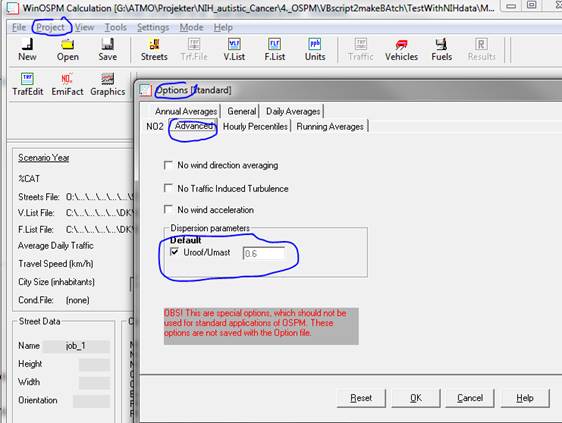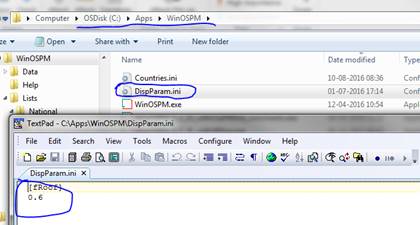Q: What shall I do if I have not enough meteorology or background concentration information? For example, if I don't have the "global radiation" and the "background data" hour by hour?
A:
WinOSPM will only perform calculations for those hours for which sufficient information on meteorology and background is available. The minimum requirements for the meteorological data are wind speed and wind direction. Global Radiation is only used in connection with calculations of NO2. If global radiation is not available, NO2 will not be calculated but concentrations of all the other compounds will be calculated.
Background data are necessary for calculation of the total street concentrations. The model will always calculate the "street contribution" but the total concentrations can only be calculated if background is available too. Remember that total concentration = background + street contribution. You can always write all the model results to hourly output files and if you don't have background data you will only be able to output the "street contributions". The only exception is NO2, for which you always need background concentrations of NOx, NO2 and ozone. It's not possible to calculate the street contribution of NO2. The relationship between the NO2 concentrations in a street and NOX emissions is non-linear and the simple addition of background and street contribution is not possible.
Q: The model is looking for "global radiation" as an input. Is that the short-wave solar radiation (direct plus reflected) coming downward from the sky? Where do I usually get those data?
A: The global radiation is used for calculation of photodissociation of NO2. If you are not going to calculate NO2 concentrations, the global radiation is not required at all. By definition, the global radiation is the total downward flux of the short-wave solar radiation (not Net Radiation!). Usually we have the data on the global radiation from direct measurements with piranometers but it can also be calculated using empirical formulas based on solar elevation and cloud cover.
When dealing with NO2, the modelled concentrations in a street are not very sensitive to global radiation, so even a crude estimation of this parameter is sufficient.
Another place where the global radiation is used in the model, and actually not in the street dispersion part (which is the core OSPM model) but in the Windows package - WinOSPM, is for calculation of the urban background contribution. WinOSPM contains a very simplified module, which can be used for a simple calculation of the urban background and here the global radiation is used as a surrogate for the sensible heat flux for estimation of the dispersion in unstable conditions. Even here, the model calculations can be done without the global radiation. The conditions will be assumed to be always neutral. When using WinOSPM, there are no restrictions on the meteorological input parameters. The minimum requirements are wind speed and wind direction, but NO2 will not be calculated if the global radiation is missing.
Q: I have meteorological measurements at a mast, but not at roof level. How should I determine roof level wind speed?
A: Roof level wind speed u_roof is used and calculated inside the model. It is assumed to be proportional to u_mast - a wind speed input by the user and measured (or modelled) at a meteorological mast. The proportionality factor f_Roof (u_roof / u_mast) can be specified in the model. The default proportionality factor has been adjusted a few times since the first version of OSPM, see also next question.
Q: What is the value of the f_Roof factor and how do I adjust it? What about the height of the u_mast over the roof level? Is there some determination for the u_mast height?
A: The discussion about the wind speed / f_Roof factor is really tricky and you should keep in mind that OSPM is a “parameterized” model.
The original value was 0.82, but later we used a factor of 0.4.
See the discussion on page 2 in Ketzel et al. 2012 (J Civil Environ Eng, S1:004.(doi-Link))
Since that paper we did some more adjustments in the way we estimate the travel speed that again influenced our emission that led to another adjustment of the f_Roof factor to 0.6.
There are two ways to change the f_Roof factor
a) When you have a project open, you can change f_Roof, “case by case” under Project => Options => Advanced:

And b) in the file DispParam.ini you can set the default value:

In our case the masts we use the wind speed data from as input are about 7 m high and are located at the roof of some 15 - 20_m high building in the city center close to the monitoring station.
We have been trying to develop at meteorological pre-processor to determine the f_Roof factor at more solid ground and a paper is close to be submitted on this.
A: NOx emission, QNOx and other emission outputs are in units of µg/m/s, when emissions factors are provided in g/(veh km) units.
For particle numbers: emission factors are given in 1014 #/(veh km) and emission output Q_Pnumber is given in 1014 #/(m s), while concentrations are given in #/(cm3).
Q: How can I implement my own national emissions into WinOSPM?
A: There are various ways of adjusting / implementing your 'own' emissions with increasing degree of complication:
i) Keep the Danish emission setting, but ignore the consistency between your calculation year and the 'emission year'. Simply select an emission year (by choosing an *.VLF file) where the overall emission factors match your national emissions.
ii) Read a pre-calculated, so called 'traffic emission profile - *.TEM' file. The structure of a traffic emissions file is similar to a traffic (*.TRF) file and gives a pattern of changing hourly emissions, that is assumed to repeat daily or weekly. An example is given here.
iii) Read emissions and traffic directly hour by hour from the input file. Also here an example is provided.
iv) Implement your own emission data set. This requires substantial effort - and is only recommended for advanced users!! An example for a very simple set of constant emission factors for Vietnam (VN) is given here. It was developed / implemented by Hung et al. 2010 (J. Air & Waste Manage. Assoc..(doi-Link)). You need to copy the files into the corresponding folders on your PC (e.g. C:\Apps\WinOSPM\Lists\ or C:\Apps\WinOSPM\Data\ ...).
Q: What average building heights and what variability in building heights are acceptable? For example, Manhattan has street canyons with average building heights of 60 or 80 m and occasional tall buildings of height 150 to 250 m. Is there an upper limit where the model has not been tested or is not expected to be valid?
A: In principle there are no restrictions on building heights or variability of building heights. However, this is only in "principle", i.e. the model calculations will be done with any building height (except negative!) and some results will came out of the model calculations. However, we have never tested the model with "Manhattan-type" streets and the user should be aware about that OSPM is a very simplified empirical model. The basic assumption is that a single street vortex is created in a street and this might not be true when dealing with streets with an aspect ratio much higher than 1. Until now we had no data available from such locations and it would be very interesting to test the model assumptions on actual field measurements.
Q: In the manual a limit of 75 m for the street length is mentioned, what if I have different distances in my city?
A: The "street length" parameter is not very restrictive. In OSPM, the street concentrations are calculated by a simple integration of contributions from traffic emissions along the wind path at the street level. These contributions decrease with the distance from the calculation point and only in the case when the wind direction is close to parallel with the street, the assumed length of the street can be important. The definition is not very strict. The 75 m limit should only be considered as a practical recommendation and not as an actual limit; we often use a range of 50 m to 200 m for practical applications. In OSPM it is assumed that the horizontal diffusion is restricted by the street width. If there are many wide openings in the street, part of the pollution will probably diffuse through these openings and the model will in this case over-predict the concentration levels.
Q: It is possible, but not compulsory to input the mixing height Hmix into the OSPM model. What is the role of the mixing height?
A: Hmix is presently not used in the model.